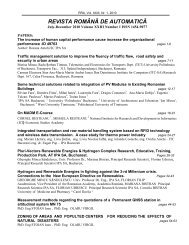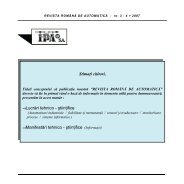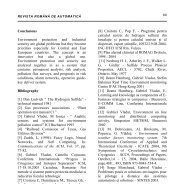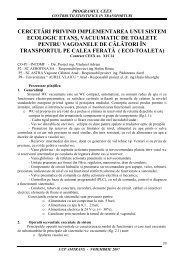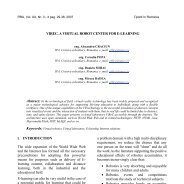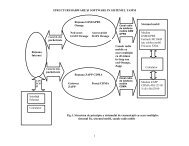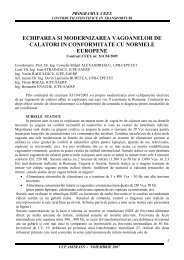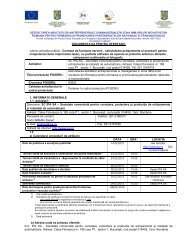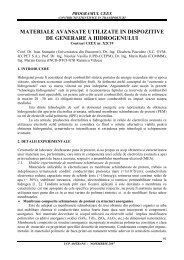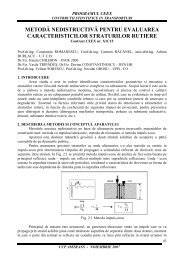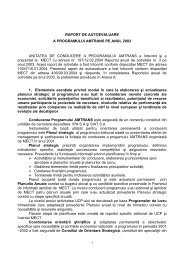REVISTA ROMÃNÄ DE AUTOMATICÄ - IPA SA
REVISTA ROMÃNÄ DE AUTOMATICÄ - IPA SA
REVISTA ROMÃNÄ DE AUTOMATICÄ - IPA SA
You also want an ePaper? Increase the reach of your titles
YUMPU automatically turns print PDFs into web optimized ePapers that Google loves.
<strong>REVISTA</strong> ROMÂNĂ <strong>DE</strong> AUTOMATICĂ<br />
19<br />
II. GENERAL PROCESS FLOW FOR<br />
DIFERENT TYPES OF HOT MIX<br />
ASPHALT PAVING MATERIALS<br />
PRODUCTION PLANTS<br />
Batch Mix Plants<br />
Figure 1 shows the batch mix HMA<br />
production process. Raw aggregate<br />
normally is stockpiled near the production<br />
unit. The bulk aggregate moisture content<br />
typically stabilizes between 3 to 5 percent<br />
by weight.<br />
Processing begins as the aggregate is hauled<br />
from the storage piles and is placed in the<br />
appropriate hoppers of the cold feed unit.<br />
The material is metered from the hoppers<br />
onto a conveyer belt and is transported into<br />
a rotary dryer (typically gas- or oil-fired).<br />
Dryers are equipped with flights designed<br />
to shower the aggregate inside the drum to<br />
promote drying efficiency.<br />
As the hot aggregate leaves the dryer, it<br />
drops into a bucket elevator and is<br />
transferred to a set of vibrating screens,<br />
where it is classified into as many as four<br />
different grades (sizes) and is dropped into<br />
individual “hot” bins according to size. At<br />
newer facilities, RAP also may be<br />
transferred to a separate heated storage bin.<br />
To control aggregate size distribution in the<br />
final batch mix, the operator opens various<br />
hot bins over a weigh hopper until the<br />
desired mix and weight are obtained.<br />
Concurrent with the aggregate being<br />
weighed, liquid asphalt cement is pumped<br />
from a heated storage tank to an asphalt<br />
bucket, where it is weighed to achieve the<br />
desired aggregate-to-asphalt cement ratio in<br />
the final mix.<br />
The aggregate from the weigh hopper is<br />
dropped into the mixer (pug mill) and drymixed<br />
for 6 to 10 seconds. The liquid<br />
asphalt is then dropped into the pug mill<br />
where it is mixed for an additional period of<br />
time. At older plants, RAP typically is<br />
conveyed directly to the pug mill from<br />
storage hoppers and combined with the hot<br />
aggregate. Total mixing time usually is less<br />
than 60 seconds. Then the hot mix is<br />
conveyed to a hot storage silo or is dropped<br />
directly into a truck and hauled to the job site.<br />
Parallel Flow Drum Mix Plants<br />
Figure 2 shows the parallel flow drum mix<br />
process. This process is a continuous mixing<br />
type process, using proportioning cold feed<br />
controls for the process materials. The major<br />
difference between this process and the batch<br />
process is that the dryer is used not only to dry<br />
the material but also to mix the heated and<br />
dried aggregates with the liquid asphalt cement.<br />
Aggregate, which has been proportioned by<br />
size gradations, is introduced to the drum at the<br />
burner end. As the drum rotates, the aggregates,<br />
as well as the combustion products, move<br />
toward the other end of the drum in parallel.<br />
Liquid asphalt cement flow is controlled by a<br />
variable flow pump electronically linked to the<br />
new (virgin) aggregate and<br />
RAP weigh scales. The asphalt cement is<br />
introduced in the mixing zone midway down<br />
the drum in a lower temperature zone, along<br />
with any RAP and particulate matter (PM) from<br />
collectors.<br />
The mixture is discharged at the end of the<br />
drum and is conveyed to either a surge bin or<br />
HMA storage silos, where it is loaded into<br />
transport trucks. The exhaust gases also exit the<br />
end of the drum and pass on to the collection<br />
system.<br />
Parallel flow drum mixers have an advantage,<br />
in that mixing in the discharge end of the drum<br />
captures a substantial portion of the aggregate<br />
dust, therefore lowering the load on the<br />
downstream PM collection equipment. For this<br />
reason, most parallel flow drum mixers are<br />
followed only by primary collection equipment<br />
(usually a baghouse or venturi scrubber).<br />
However, because the mixing of aggregate and<br />
liquid asphalt cement occurs in the hot<br />
combustion product flow, organic emissions<br />
(gaseous and liquid aerosol) may be greater<br />
than in other asphalt mixing processes. Because<br />
data are not available to distinguish significant<br />
emissions differences between the two process<br />
designs, this effect on emissions cannot be<br />
verified.



